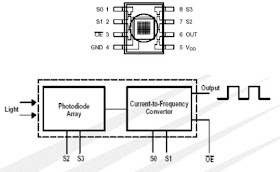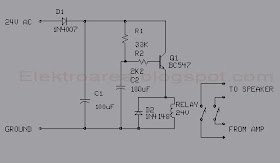Sensor Warna TCS230
TCS230 color sensor is a converter IC to the frequency of light colors. There are two main components of this IC makers, namely photodioda and current to frequency converters. Each color can be drawn from the basic colors. To light, color is the color of the basic constituent Red, Green and Blue, or better known as RGB (Red-Green-Blue).
TCS230 color sensor is a converter IC to the frequency of light colors. There are two main components of this IC makers, namely photodioda and current to frequency converters. Each color can be drawn from the basic colors. To light, color is the color of the basic constituent Red, Green and Blue, or better known as RGB (Red-Green-Blue).
Photodiode on IC TCS230 array arranged in a 8x8 configuration: 16 Photodiode for red menfilter, 16 Photodiode for the green filter, 16 Photodiode for the blue color filter, and unfiltered Photodiode 16. Photodiode groups which will be used can be arranged through the leg selector S2 and S3.
Photodiode will issue the amount of current is proportional to the level of the basic colors of light that happened. This current is then converted into a signal box with a frequency proportional to the amount of current. Output frequency can be scaled by adjusting the leg selector S0 and S1.
Thus, programs that we need to get the RGB composition is a frequency counter program. There are two typical ways to calculate the frequency. The first way: We create a timer berperiode 1 second, and during that period we count how many times a wave box.
 in the picture above
in the picture above
1 second place in 1000 wave means the frequency is 1000Hz or 1khz
 in the picture above
in the picture above1 second place in 1000 wave means the frequency is 1000Hz or 1khz

















































